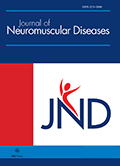Authors: Semplicini, Claudio | Agostini, Michela | Andrigo, Cinzia | Masiero, Stefano | Piccione, Francesco | Sorarù, Gianni
Article Type:
Short Communication
Abstract:
Objective: Exoband (by Moveo, Padova, Italy) functions as a walking brace, comprising a belt and two leg loops connected by a mechanism that stores energy during the initial phase of the gait cycle and releases it in the subsequent phase. This enhances hip flexor thrust, leading to functional improvement in walking for individuals with conditions characterized by proximal weakness. It has been approved as a passive wearable device for individuals with impaired walking abilities. Objective of this study was to establish a protocol to assess the use of Exoband in patients with various neuromuscular disorders. Methods: This exploratory
…retrospective study includes consecutive patients diagnosed with neuromuscular disorders (CIDP, motor polyneuropathy, MND), exhibiting a proximal involvement and gait abnormalities. The evaluation protocol incorporated specific walking-related outcome measures, the 10-meter walk test (10mWT), Time-up-and-go test (TUG), and 2-minute walking test (2MWT). The assessments were conducted both with and without the Exoband under standard conditions. Results: Eight patients (6 males, aged 60–78 years) were tested. An increase in velocity was observed in the 10mWT (median 13.4 sec, IQR 12.0–15.7 vs. 12.2 sec, IQR 11.3–14.2 seconds, p < 0.05) and the TUG (14.0 sec, IQR 13–16.2 vs 13.35 sec, IQR 11–13.8; p < 0.05, by non-parametric Wilcoxon test), and a trend of increase in 2MWT (median 88.2 vs 92.6 m, n.s.). Six out of 8 patients reported subjective benefits from the very first use, including improved walking stability, speed, confidence, and reduced fatigue. Conclusions: Our protocol provides a quantitative assessment of Exoband usefulness for patients affected by neuropathies with gait abnormalities. Further investigations are warranted to assess the long-term effects of its regular Exoband use, its efficacy in specific neuromuscular diseases, and its potential role as a rehabilitation device.
Show more
Keywords: Gait abnormalities, neuromuscular disorders, rehabilitation, exoskeleton
DOI: 10.3233/JND-240021
Citation: Journal of Neuromuscular Diseases,
vol. 11, no. 4, pp. 877-881, 2024





